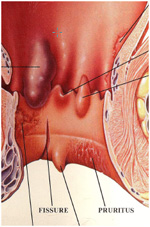 Some patients experience a history of pain in the anal area accompanying a bowel movement. When the pain is severe and typically described as a cutting, knife-like pain at the time of a hard stool, the problem may be caused by a fissure in ano. There is often a small amount of bleeding at the time of the movement. The fissure is actually a tear in the surface of the tissue and is often in the posterior midline. A tag of tissue called the sentinel tag is present in chronic cases. Following the movement, the patient senses an aching throbbing due to spasms of the inflamed underlying muscle; constipation follows, and with the next movement—that is often large and hard again—reinjury occurs, and the vicious cycle of pain and constipation begins anew.
Some patients experience a history of pain in the anal area accompanying a bowel movement. When the pain is severe and typically described as a cutting, knife-like pain at the time of a hard stool, the problem may be caused by a fissure in ano. There is often a small amount of bleeding at the time of the movement. The fissure is actually a tear in the surface of the tissue and is often in the posterior midline. A tag of tissue called the sentinel tag is present in chronic cases. Following the movement, the patient senses an aching throbbing due to spasms of the inflamed underlying muscle; constipation follows, and with the next movement—that is often large and hard again—reinjury occurs, and the vicious cycle of pain and constipation begins anew.
Various approaches are practiced in the treatment of a fissure. The first is the use of laxatives and stool softeners, but this is only successful 15% of the time. Cardizem in combination with lidocaine applied to the fissure is very effective without the side effects of nitrate proparations. Foreceful dilatation is asscociated with complications and not currently done. Botox injections are expensive, often ineffective and not durable.
Anal Fissure Treatment in the Tampa Bay Area
I often see many patients dealing with severe pain during their movements. The pain is very severe and some patients try to limit their movements in search of relief, but eventually results in a larger volume, harder and more painful stool. People have seen other physicians or have admitted themselves to the emergency room for relief and are often given incorrect treatment and have undergone painful examinations.
Pain sometimes described by my patients as sharp, burning and almost like broken glass. Followed by aching and throbbing pain that last for hours, often with blood. This is a textbook scenario of an Anal Fissure. The fissure is actually a tear or a wound in the sensitive anal tissues.
Unfortunately, patients have often received recommendations for Preperation H and other steroid suppositories, both of which interfere with wound healing. Wounds require a healthy amount of blood to heal properly. Preperation H and Phenylephrine are vasoconstrictors which decrease your blood supply.
Patients often come to me saying they were subjected to a very painful examination. This can happen when a physician doesn’t consider the diagnoses of a fissure with a classic history and does a full and painful digital rectal exam. This is unnecessary. When I hear a patient’s history that sounds typical for a fissure, I conduct a very gentle superficial palpation of the area, which confirms the diagnoses when the patient reports pain and discomfort. The examination stops at that moment and no further examination is necessary to make the diagnosis.
Initial treatment consists of the placement of the cream, that contains medication to help in relaxing the muscle that causes aching and throbbing. This treatment allows the wound to heal in addition to a topical anesthetic to provide some relief. However, if this is not successful a minor surgical procedure can be done in the office with local anesthesia. That is almost always successful. However, we typically prefer noninvasive techniques first before proceeding to a surgical procedure.
The most definitive treatment is the subcutaneous lateral internal sphincterotomy. It is an office procedure done under local anesthesia. Complications of this minor procedure are rare, and, rather than post-procedure pain, most patients experience almost immediate relief of the severe pain of the fissure.
Dr. Shapiro is a veteran surgeon who is experienced in the diagnosis and treatment of patients with fissure in ano. If you’re experiencing pain associated with a bowel movement or any other symptoms associated with Hemorrhoidal Disease, contact the Hemorrhoid Treatment Center of Florida today at (727) 724-4279 today to schedule an appointment with a physician today. Relief from pain is only an office visit away.








